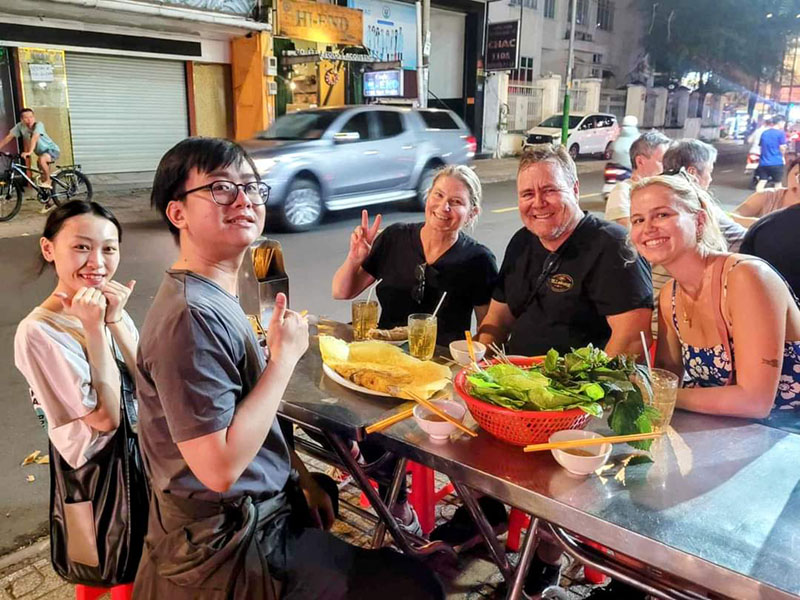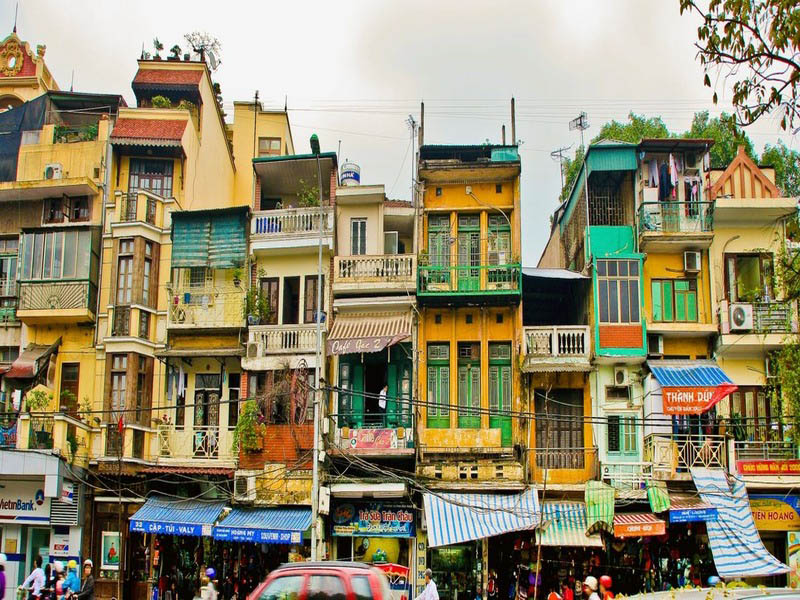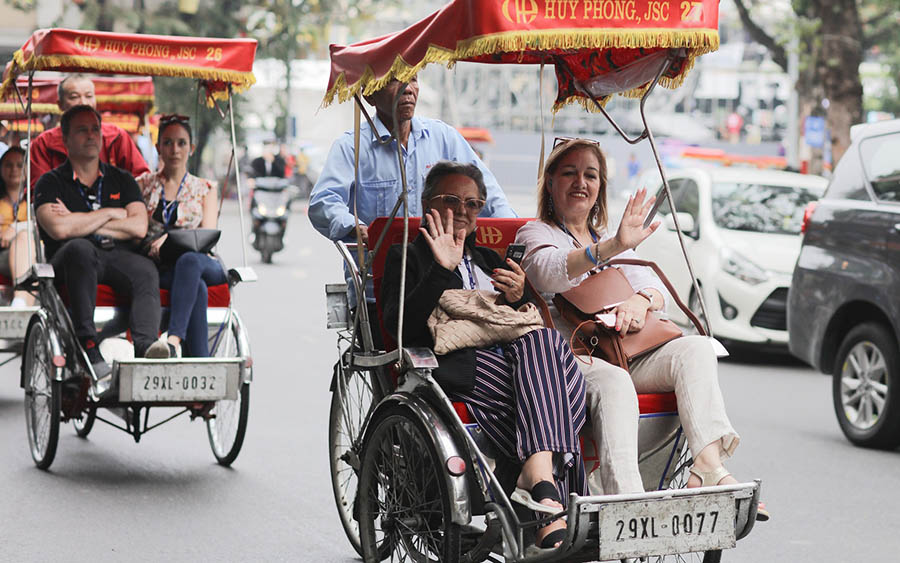Useful Information for Visiting Cu Chi Tunnels
The Cu Chi Tunnels were constructed on a patch of land nicknamed "iron land" - not just to describe the firmness of the ground, but also to praise the resolute defensive spirit of the people here. The expansive underground system covering 250km, contained hospitals, living quarters, kitchens, storage depots, and workspaces.
The tunnel in Vietnamese is written as Củ Chi. If you would like to give the pronunciation of this location a try, "Cu Chi Tunnels" can be pronounced as "Koo Chee Tunnels."
Where is Cu Chi Tunnel
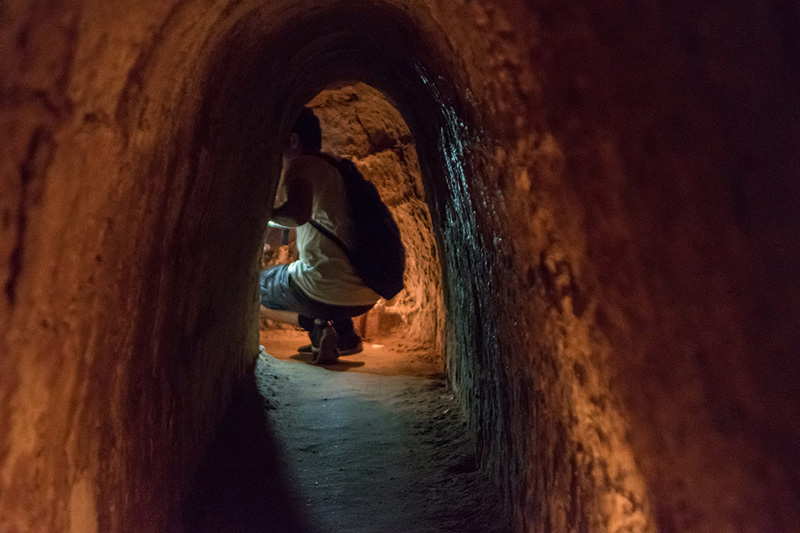
Exploring history that lies beneath the ground but is not buried in Cu Chi Tunnels
Nestled within the bounds of Cu Chi District, an outlying district of the bustling Ho Chi Minh metropolis, one can find the extraordinary subterranean labyrinthine of Cu Chi Tunnels. The tunnel sits an estimated distance of 70 km in a Northwesterly direction from the urban center.
Exact location: Phu Hiep Hamlet, Provincial Road 15, Phu My Hung Commune, Cu Chi District, Ho Chi Minh City.
How to get to Cu Chi Tunnels
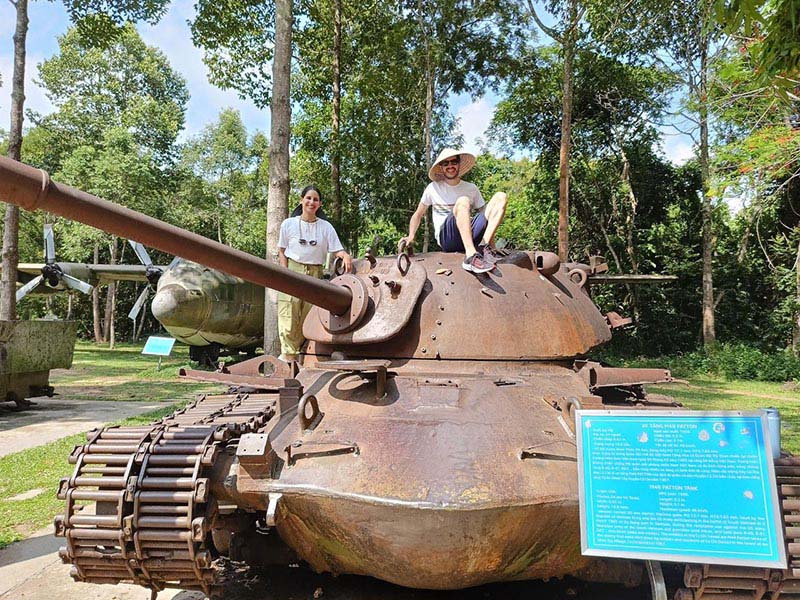
Check-in with the US Army tank at Cu Chi Tunnels
Embarking on a journey from Ho Chi Minh to Cu Chi Tunnels takes approximately 1.5 hours, and there are a plethora of transportation options to choose from as you start to venture from the bustling city:
|
Types of Transport |
How to travel |
Cost |
|---|---|---|
|
Bus |
To venture forth into the historic site of Cu Chi, visitors can choose either Ben Dinh or Ben Duoc areas: - Travelers bound for Ben Dinh of Cu Chi Tunnels opt to board either Bus No. 13 or 94 and alight at An Suong Bus Stop. From there, hop on Bus No. 122 and disembark at Tan Quy prior to switching to Bus No. 70, which ultimately leads to the final destination of Ben Dinh. - Alternatively, to visit Ben Duoc, you can take bus number 13 or 94 and stop at the Cu Chi bus station. From there, switch to bus number 79 to reach Ben Duoc of Cu Chi. |
7,000 - 9,000 VND/bus ticket (about 0,3 - 0,4 USD) |
|
Taxi |
As a convenient and private mode of transportation, taxis can be quite pricey with fares ranging from 11,000 - 15,000 VND/km (0.47 - 0.64 USD). Taxis can be booked through various means including booking through your hotels, booking online via mobile applications, or hailing one on the street. |
About 770,000 - 1,050,000 VND/car/one way (33 - 45 USD) |
|
Motorbike |
Riding a motorbike is a versatile and exciting option for commuting from Ho Chi Minh to Cu Chi Tunnels, as you can relish the picturesque scenery on either side of the road while indulging in the exhilarating sensation of the fresh open air. |
The rental fee for motorbikes in Ho Chi Minh City ranges from 100,000 to 160,000 VND per day, plus an additional cost of approximately 21,000 VND per liter for fuel. |
|
Boat |
One could arrange for a speedboat ride to traverse the Saigon River all the way to Cu Chi. |
Cu Chi Tunnels round trip speedboat tour for half-day or one-day tour is from 900,000 - 2,000,000 VND/adult (about 38 - 85 USD). |
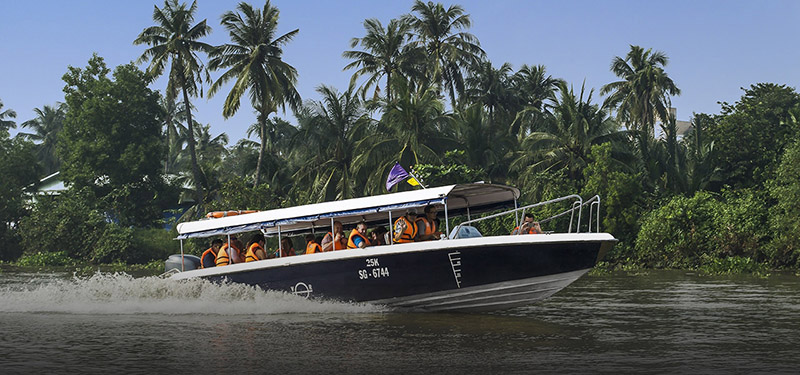
Travel to Cu Chi Tunnels by speedboat
Cu Chi Tunnels Entrance Fee
Below are the ticket prices applicable to visiting Cu Chi Tunnels:
-
Ben Duoc Tunnels: 110,000 VND/person (about 5 USD).
-
Ben Dinh Tunnels: 90,000 VND/person (about 4 USD).
Opening hours: From 7 am - 5 pm daily.
Cu Chi Tunnels Guide Map
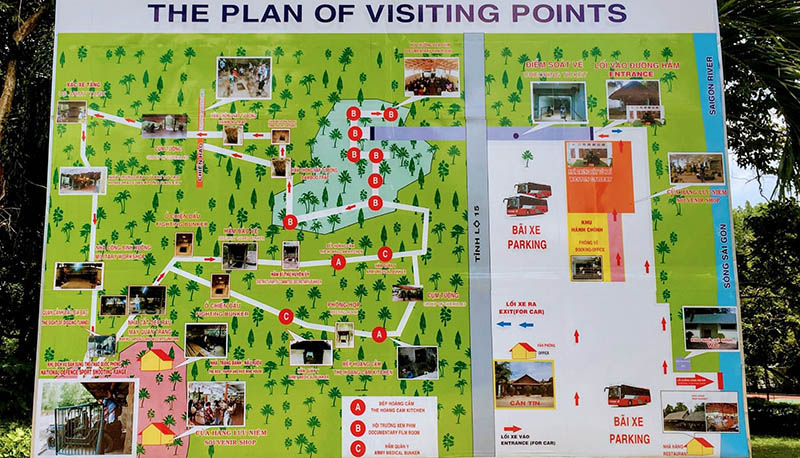
Cu Chi Tunnels map - The plan for visiting points
The Cu Chi Tunnels are located in a large area, and you can follow the forest paths to visit various tourist spots. Based on the Cu Chi Tunnels map, some places to visit are:
-
Documentary film rooms.
-
Army medical bunkers.
-
The Hoang Cam Stove.
-
Group of guerrillas.
-
Army meeting room.
-
Bamboo traps.
-
District party committee secretary bunker.
-
Fighting trenches.
-
Secretary guard bunker.
-
Fighting bunker.
-
US Army tank.
-
Homemade weapons gallery.
-
Military workshop.
-
The sight of a digging tunnel.
-
National defense sport shooting range.
-
Making sandals and military uniforms.
-
The rice paper and rice wine house.
-
Weapon gallery.
Some of the service utilities available in the area:
-
Souvenir shop.
-
Restaurants.
-
Toilets.
-
Parking areas.
-
Ticket office.
A brief history of Cu Chi Tunnels
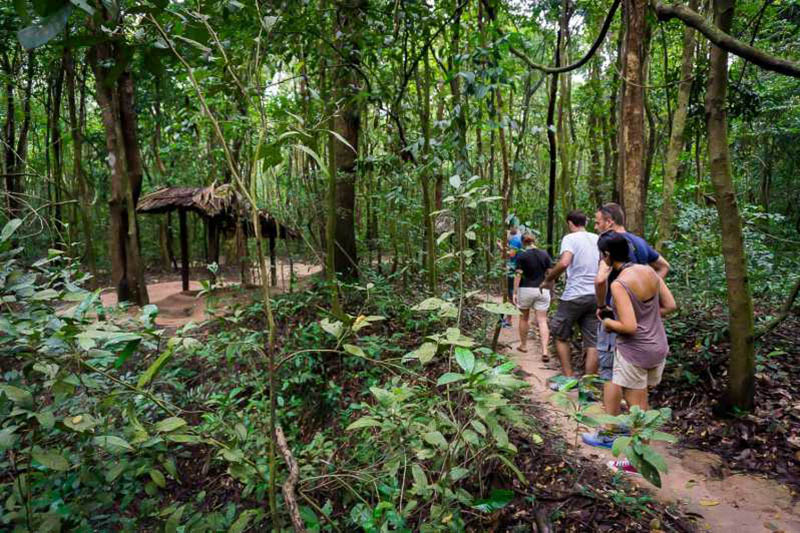
Explore the impressive and mysterious fortified underground tunnels of the Vietnamese military and people through various pathways
The formation of the Cu Chi tunnels dates back to the period of resistance against French colonialism, approximately between 1946 and 1948. At the outset, these tunnels were small, basic constructions utilized for the purposes of storing weapons and confidential papers, as well as keeping people hidden from view.
Throughout the resistance war against the United States, the underground tunnel system underwent reinforcement and expansion. In the beginning, the village took it upon themselves to construct their own underground tunnel system; however, the necessity for transport between these tunnels catalyzed the development of a complex system of interconnected tunnels. Over time, this system evolved into a sophisticated network that spanned a vast expanse of land.
The people of Cu Chi devoted themselves to creating an unparalleled system of defense. They tirelessly dug intricate transportation trenches and complex tunnels, which were skillfully organized into layers and narrow pathways. Additionally, they implemented a range of strategic defensive measures such as combat brigades, minefields, spike pits, and bunkers, all interconnected in clusters to form an impenetrable stronghold. This impressive system became known as the 'combat hamlet', a marvel of guerrilla warfare.
For a comprehensive look, don't miss our post on Vietnam guide for first timers!
What to See in Cu Chi Tunnels?
As you may already know, tourists can visit Cu Chi through two tunnels - Ben Dinh and Ben Duoc. In essence, Ben Dinh is more accessible to tourists, as it spans 17 hectares and can be traversed on foot. The tour programs for these two tunnels are quite similar, with a few notable differences.
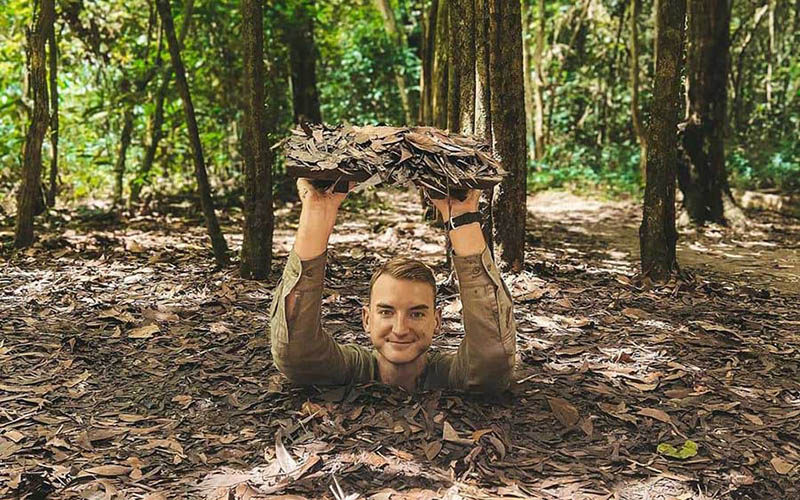
Visitors are fascinated when exploring the hiding method of Vietnamese people and army in the forest of Cu Chi
Ben Dinh Tunnels
When visiting the Cu Chi Tunnels, tourists will have the opportunity to watch short documentaries in the auditorium and listen to a guide's introduction about the history and development of the Cu Chi tunnel system. After that, tourists will be taken on a tour of the underground tunnel system, seeing the living quarters, meeting spaces, weapon workshops, self-made weapon exhibitions, and M41 tanks, along with participating in various games, visiting souvenir shops, and enjoying specialty food.
The distinctive feature of the Ben Dinh travel route compared to Ben Duoc is that visitors will have the opportunity to explore the Cu Chi Tunnels along the Provincial Highway 15, fighting trenches, the soldier's station, the anti-aircraft gun bunker, and the sculpture area depicting the life and struggle of the Vietnamese people during the war.
Ben Duoc Tunnels
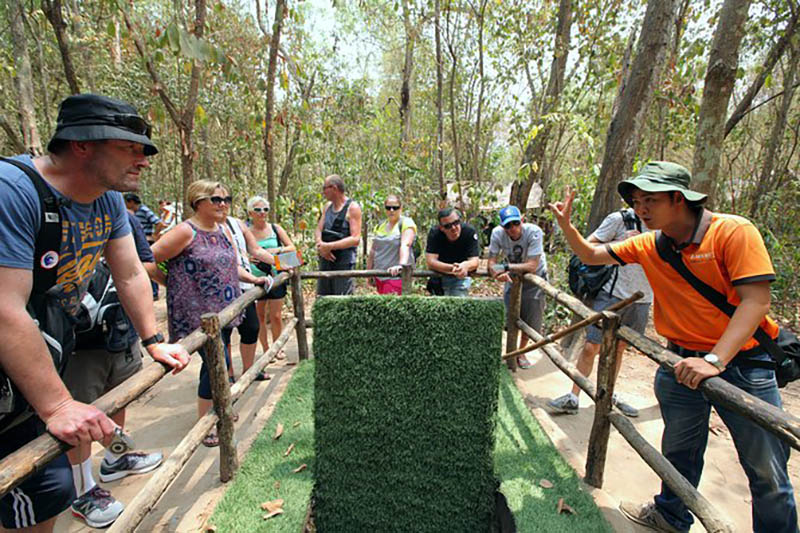
The tour guide explains how the traps work at Cu Chi Tunnels
Ben Duoc boasts a total area of approximately 100 hectares. To discover this place, you need to combine walking and riding an electric car. This base serves as the command center for military operations, facilitating the coordination of combat activities. What sets Ben Duoc apart from Ben Dinh are its unique attractions:
-
Visitors can admire the dioramas of guerrilla warfare, explore the underground tunnels, witness the secret bunkers and battlefields.
-
Explore the military uniform and equipment museum.
-
In addition, you can pay your respects at the Memorial Temple dedicated to the fallen soldiers of Ben Duoc, and admire the largest ceramic mural in Vietnam here.
What to Do in Cu Chi Tunnels?
Besides visiting the impressive historical tunnels of Cu Chi, there are also many exciting experiences for you to try here:
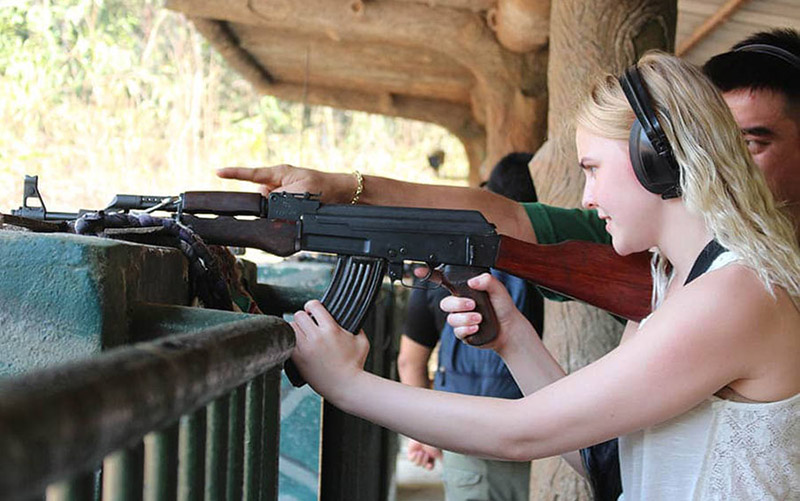
Test your shooting skills at the Cu Chi Tunnels shooting range
-
Shooting at the Military Sports Center: This adrenaline-inducing sport is a popular choice among tourists. You can choose from a variety of guns used during the war and, after receiving full instructions, you can try shooting at animal-shaped targets and moving targets.
-
Paintball shooting game: tourists will feel like real warriors engaged in an epic battle. Each visitor is fully equipped with a mask, uniform, armor, and paintball gun to undergo a thrilling challenge. The experience is designed to be a collaborative effort as tourists come together for a realistic and exhilarating experiment.
-
Experiencing rural life: Amidst the overwhelming emotions of war-torn history, let's turn our attention to the serene rural life of Vietnam. With this traditional model, one can personally pluck tender seedlings and transplant them into the neatly arranged paddy fields, or you can catch fish barehanded, utilizing only a basket and a keen eye to forage through the waters.
-
Venturing into the forest games: such as trekking across canopy walkways or zipping through the trees on ziplines.
-
Visit the simulated lake of the Vietnamese East Sea: A place where you can immerse yourself in an ambiance that showcases the islands and archipelagos in the East Sea of Vietnam such as Bach Long Vi, Hoang Sa, Truong Sa, and more. Here, you can swim, paddle on swan boats, kayak, ride water bikes, or take a pontoon boat ride.
-
Riding a bicycle or an electric scooter to explore the lakeside and various destinations in the Ben Duoc area.
-
Camping: The camping and outdoor recreation area is located next to the Saigon River or the simulated lake with large and airy grounds amidst the trees.
-
Indulge in Cu Chi local cuisine: In the food area, you can enjoy traditional dishes such as rice paper, rice wine, grilled corn and sweet potatoes, and more. Additionally, you can opt for dining at the restaurants in Ben Dinh and Ben Duoc areas.
Tips for smooth experiences at Cu Chi Tunnels
This destination is perfect for year-round visits and requires minimal preparation. The Cu Chi Tunnels tour normally lasts half a day or a full day. Here are a few small notes from New Asia Tours to guide you before embarking on your adventure:
-
The journey involves mainly walking, so make sure your health is guaranteed, drink enough water, dress comfortably, and wear suitable shoes.
-
Bring mosquito repellent.
-
If you have a fear of narrow spaces, you should not go down to the tunnels. There are short tunnels, only a few meters long, but there are also longer tunnels with more floors down below.
-
Stick together, follow, and listen to the instructions of the tour guide. Do not forget that you are walking in a forest and complex tunnels.
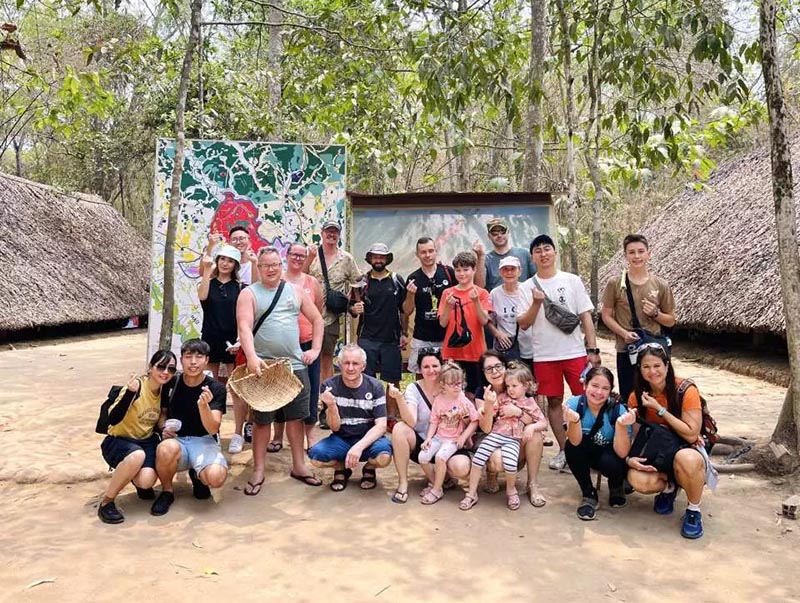
Make your day visit to Cu Chi Tunnels a wonderful day
From a typical Vietnam rural area, deep beneath the earth of Cu Chi, arose a fortress as strong as steel, striking fear into the hearts of its enemies as no bomb or shell could penetrate it. Exploring this awe-inspiring place would be a fascinating and meaningful journey, wouldn't it? If you love to discover the wonderful Vietnam tour that is customized to your liking, do not hesitate to contact your local friends of New Asia Tours!



